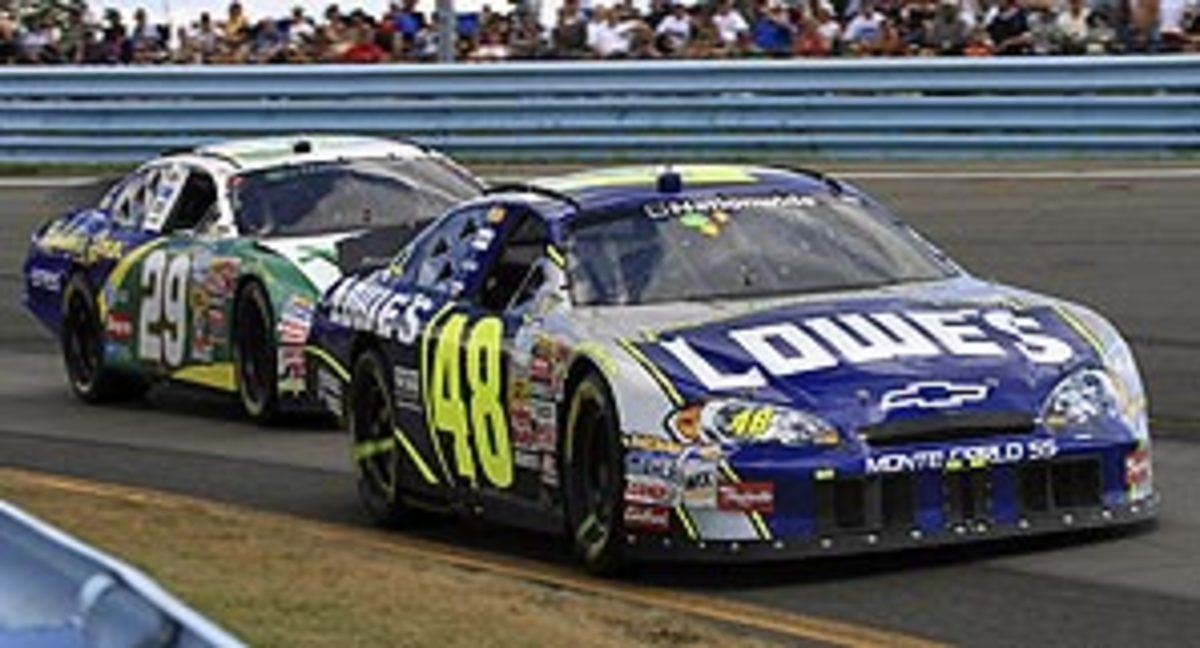Beating out Jimmie Johnson, the start-and-park controversy, more
Two-tenths of a second. If he had only been that much faster, Jeff Burton believes he could have beaten Johnson to the scoring line at the end of pit lane and put J.J. a lap down and out of contention at Fontana.
Burton's teammate Kevin Harvick had his chance. He was closing and Johnson's lead was disappearing. The No. 29's 108-race winless streak seemed like it would float away into the California breeze. But as Harvick moved within a car length of the four-time champ, he got loose and slid against the fourth turn wall, allowing Johnson to reach Victory Lane.
The cosmic force that can sway an event or, seemingly, the speed of a 3,400-pound Chevy a man's way clearly resides with Johnson, and to hear Harvick's hypothesis, it has taken up residence in the most nefarious of places. It appears it will take something other than karma to dethrone Johnson; it will take someone really, really good.
In the early goings, Richard Childress Racing's three cars have been exactly that.
After failing to put any drivers in the Chase last season, all three RCR drivers made the top-10 at Auto Club Speedway, the only track where Childress has had at least 34 starts and never won. Harvick, who had the best car on the track in the opening weeks, was second. Burton finished third and Clint Bowyer was eighth. They're also first (Harvick), second (Bowyer) and fifth (Burton) in the points standings.
Childress has shown that its strong finish to '09, when it had at least one of its drivers fifth or better over the final four races, was just the beginning of a quick rebound.
"As we move forward, you've just got to kind of forget what happened last year to a certain degree, but you have also got to remember it so that you can try to prevent that from happening again," Harvick said.
For all the changes RCR made -- from reorganization to cutting down to three cars -- that have aided the revival, it's the sense of a renewed focus with a team of veteran drivers that makes this the sexy pick to rival J.J. and Team Hendrick. Yes, we're only a 5K in to the marathon that is the Sprint Cup season, but through two weeks on two very different tracks, RCR has not only shown it has bounced back, but that it has multiple drivers who are inspired to make up for last season and ready to contend for the title this year.
2. The start-and-park menace is back in the spotlight -- or more precisely, those bright, burning lights they use in interrogations -- given the way NASCAR "randomly" confiscated Dave Blaney's No. 66 in California. NASCAR has fired the first shot by seizing a car that qualified fifth then left after 43 laps with "engine failure" and shown that it's done turning a cheek to these check-collecting teams ... which poses the question: Why wage this battle?
While I'm certainly in the minority on this, I have no problem with the start-and-park teams, and ultimately, neither should NASCAR. It's no secret that this sport has been hit harder than most by a sagging economy, which translates into less sponsorship dollars and is the reason small teams like Prism Motorsports, that don't have the backing to run a full schedule or risk wrecking a car, have to pack it in on race day just to stay afloat until they can attract a viable sponsor.
From NASCAR's end, it doesn't look good when Prism, with Blaney and Michael McDowell, can pull cars into the garage after a combined 83 laps and take home $182,090, or $30,615 more than Mark Martin received for finishing fourth. But didn't NASCAR create this monster? Start-and-park teams are playing by the established rules: qualify, start the race and get paid. Unless NASCAR is going to inspect every vehicle that posts a DNF with a mechanical issue and keep those that could return to the track from cashing in, start and parks will remain a necessary evil -- very necessary for the teams whose survival rides on those paychecks.
10.4, 125: Tony Stewart's average finish and his total laps-led at Las Vegas Speedway before the track was reconfigured in 2006.
24.2, 60: Stewart's average finish and laps-led at Vegas after the changes.
Johnson, once again. Riding the hot hand is part of the very fabric of Vegas, so why bet against the guy who's not only coming off a win, but has won three of the past five races on this track? Another driver to keep an eye on is Burton, who has the highest average finish of any active driver (9.8) and three top-7 finishes since the track alterations.
To make it on a pit crew, you have to be precise, have speed, excellent hand-eye coordination and, apparently, reflexes to rival Daniel LaRusso. Adam Mosher, rear tire carrier for Jamie McMurray's No. 1, was trying to grab a loose tire during a pit stop when Kevin Harvick pulled out of the box behind McMurray. Mosher jumped on to the hood of Harvick's car and then safely back to the pavement. Who says these guys aren't athletes?





